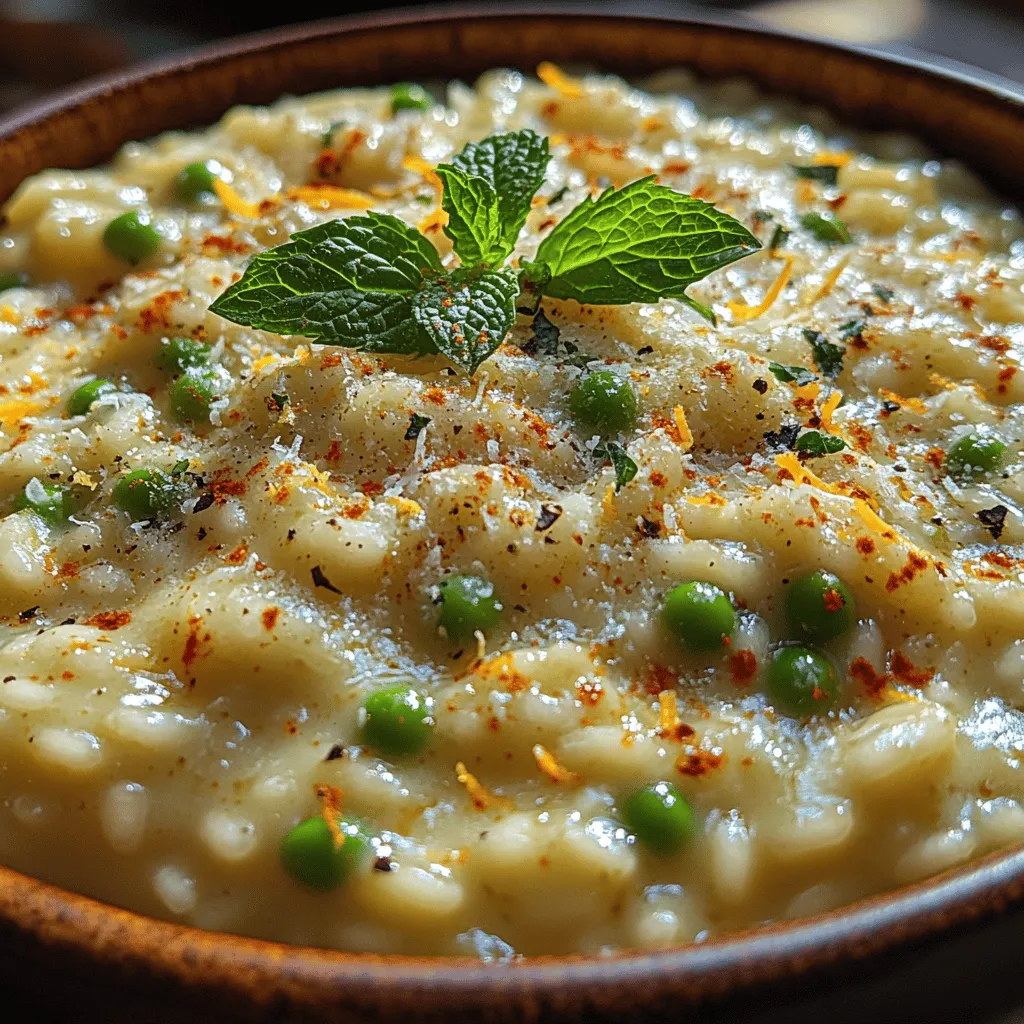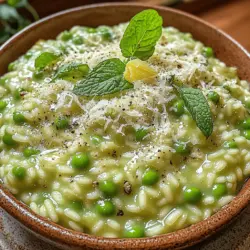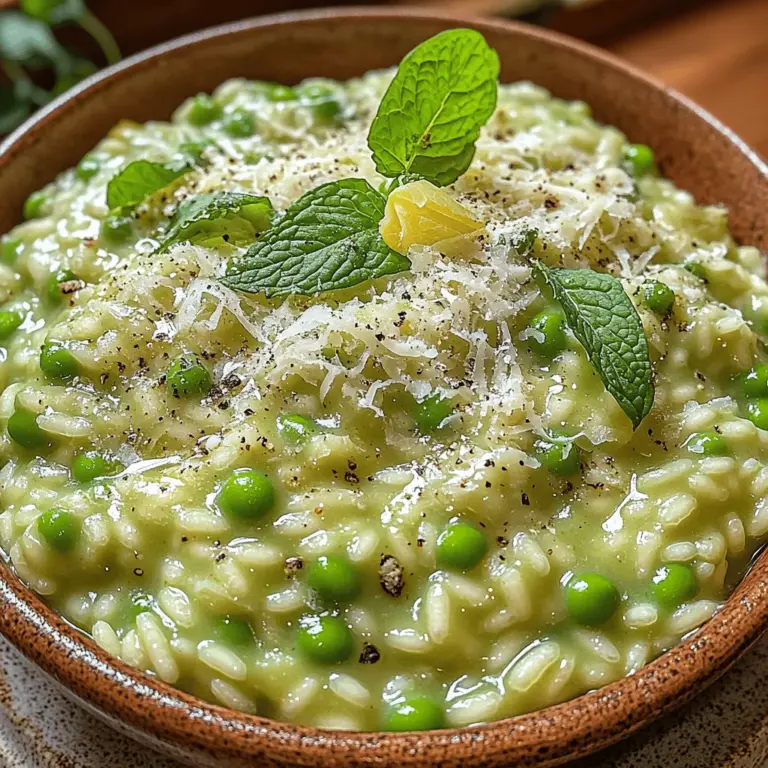Introduction
Risotto, the velvety and comforting staple of Italian cuisine, has captured the hearts and palates of food lovers around the world. This creamy dish, characterized by its rich texture and adaptability, offers endless possibilities for flavor combinations. In this article, we will explore a delightful variation of this classic dish: Creamy Spring Pea Risotto. This recipe is a vibrant celebration of spring flavors, bringing together the sweetness of fresh peas, the creaminess of Arborio rice, and a hint of brightness from citrus and herbs.
Spring is the season of renewal, and what better way to embrace it than by utilizing seasonal ingredients that not only enhance the taste of our meals but also boost their nutritional value? The Creamy Spring Pea Risotto highlights the essence of spring, showcasing the tender, sweet peas that thrive during this time of year. This dish is not just a meal; it’s a culinary homage to the freshness and vibrancy of the season.
Understanding Risotto
Risotto is a traditional Italian dish that has its roots in Northern Italy, particularly in the regions of Lombardy and Piedmont. This dish is distinguished by its unique cooking method, which involves slowly adding liquid to the rice while stirring continuously. This technique allows the rice to release its starches, resulting in a creamy consistency without the need for excessive cream or butter.
The star of any risotto is Arborio rice, a short-grain variety known for its high starch content. This rice is essential for achieving that signature creamy texture that makes risotto so indulgent. As you cook Arborio rice, it absorbs the liquid gradually while releasing starch, creating a luscious, velvety sauce that clings to each grain.
In addition to Arborio rice, several key ingredients contribute to the flavor profile of Creamy Spring Pea Risotto. These include vegetable broth, sweet peas, aromatics like onion and garlic, white wine for depth, dairy elements like heavy cream and Parmesan cheese for creaminess, fresh lemon zest for brightness, and a touch of fresh mint for a refreshing finish. Each ingredient plays a crucial role in crafting a dish that is not only delicious but also a true reflection of spring’s bounty.
Ingredients Breakdown
Arborio Rice
Arborio rice is the foundation of any great risotto. This Italian short-grain rice is characterized by its plump, round kernels and high starch content, which is vital for creating the creamy texture that risotto is known for. When cooked, Arborio rice becomes tender yet retains a slight al dente bite, making it the perfect choice for this dish. Its unique ability to absorb liquid while releasing starch makes it ideal for achieving that luxurious, creamy consistency without the need for excessive fat.
Vegetable Broth
A good risotto begins with a flavorful broth, and for our Creamy Spring Pea Risotto, low-sodium vegetable broth is the perfect choice. Using vegetable broth not only adds depth of flavor to the dish, but it also allows the natural sweetness of the peas and other ingredients to shine through. Opting for low-sodium broth is a smart choice for health-conscious cooks, as it allows you to control the saltiness of your dish while still enjoying a rich flavor profile.
Sweet Peas
The star of this risotto is undoubtedly the sweet peas. These tender green gems are packed with vitamins, minerals, and antioxidants, making them a nutritious addition to any meal. Fresh peas are typically in season during spring, offering the sweetest flavor and vibrant color that can elevate your risotto. However, if fresh peas are not available, frozen peas can serve as a convenient alternative, providing similar nutritional benefits while maintaining a sweet flavor.
Aromatics: Onion and Garlic
Aromatic ingredients like onion and garlic are essential for building the flavor base of the risotto. The onion adds a subtle sweetness and depth, while garlic introduces a fragrant, savory note that complements the sweetness of the peas. Sautéing these aromatics in a little olive oil or butter at the beginning of the cooking process creates a flavorful foundation for the risotto.
White Wine
While optional, a splash of white wine can significantly enhance the flavor of your risotto. The acidity in the wine helps to balance the richness of the dish, adding depth and complexity. It also pairs beautifully with the sweetness of the peas, elevating the overall taste experience. If you prefer to omit the wine, simply replace it with additional vegetable broth.
Dairy Elements: Heavy Cream and Parmesan Cheese
For that signature creaminess, heavy cream and freshly grated Parmesan cheese are essential components of our Creamy Spring Pea Risotto. The heavy cream adds a luxurious texture, making the risotto velvety and rich. Meanwhile, the Parmesan cheese introduces a salty, umami flavor that rounds out the dish. For the best results, use high-quality cheese, as it will have a more pronounced flavor and melt beautifully into the risotto.
Lemon Zest
A touch of lemon zest is a simple yet effective way to brighten the flavors of the risotto. The citrus notes cut through the richness of the cream and cheese, adding a refreshing element that balances the dish. A little zest goes a long way, so be sure to use it sparingly to avoid overpowering the delicate flavors.
Fresh Mint
To finish off our Creamy Spring Pea Risotto, a sprinkle of fresh mint adds a delightful touch of flavor and a pop of color. Mint pairs beautifully with peas, enhancing their sweetness while contributing its own unique aroma. Adding fresh herbs at the end of the cooking process ensures that their flavors remain vibrant and aromatic, making for an appealing presentation.
Step-by-Step Cooking Instructions
Preparing the Broth
Before diving into the risotto-making process, it’s essential to prepare your broth. For an optimal cooking experience, keep your vegetable broth warm in a saucepan over low heat. This step is crucial, as adding cold broth to the risotto can shock the cooking process and prevent the rice from cooking evenly. A warm broth allows the Arborio rice to absorb the liquid gradually, promoting that signature creamy texture we’re aiming for.
With your broth prepared and the ingredients at the ready, you’re now set to embark on the delightful journey of creating your Creamy Spring Pea Risotto. Each step will bring you closer to a dish that not only embodies the essence of spring but also delights the senses with its vibrant flavors and creamy richness. As we progress through the cooking instructions, we will ensure that every element comes together harmoniously, resulting in a risotto that is as satisfying to make as it is to eat.

Sautéing Aromatics: Techniques for Achieving the Perfect Sauté
The foundation of any great risotto lies in the sautéed aromatics. For our Spring Green Delight: Creamy Spring Pea Risotto, we begin by finely chopping onions and garlic. The key to a successful sauté is to use medium heat and a good quality olive oil. Heat the oil in a heavy-bottomed pot or a large skillet. Once the oil shimmers, add the onions and cook them until they become translucent, about 5-7 minutes. This gentle cooking releases the onions’ natural sugars and enhances their sweetness, creating a flavorful base for your risotto.
Next, add minced garlic to the sautéed onions. Garlic cooks quickly, so stir it in for only about 30 seconds until fragrant. Avoid browning the garlic, as it can turn bitter. The aromatics not only provide flavor but also set the stage for the rice, allowing it to absorb these delightful undertones as it cooks.
Toasting the Rice: How This Step Impacts the Flavor and Texture of the Risotto
Toasting the rice is a crucial step that enhances the overall flavor and texture of your risotto. Use Arborio rice, the traditional choice for risotto, known for its high starch content which contributes to that creamy consistency. Once your aromatics are perfectly sautéed, add the rice directly to the pot. Stir the rice for about 2-3 minutes, allowing each grain to become slightly translucent and coated with the oil.
This toasting process develops a nutty flavor and creates a protective layer around the grains, preventing them from becoming mushy during cooking. It also helps the rice retain its shape, ensuring that each bite has a pleasant texture.
Deglazing with Wine: The Science Behind This Technique and Its Optional Nature
After toasting the rice, it’s time to deglaze with wine. Pour in about ½ cup of dry white wine, such as Sauvignon Blanc or Pinot Grigio, and stir continuously. This process is not just about flavor; it’s a scientific method that lifts the fond (the brown bits of flavor stuck to the bottom of the pot) and incorporates it into the dish. The acidity of the wine balances the richness of the risotto, while its fruity notes enhance the overall taste.
Allow the wine to simmer until it has mostly evaporated, which should take about 2-3 minutes. If you prefer to skip the wine due to dietary restrictions or personal preference, you can substitute it with vegetable broth or simply omit it altogether. The risotto will still turn out deliciously creamy.
Cooking the Risotto: Tips for Achieving Al Dente Rice and Creamy Consistency
Now, let’s focus on the cooking process, which is where the magic happens. Gradually add warm vegetable broth—about 1 cup at a time—into the rice mixture, stirring frequently. This gradual addition allows the rice to absorb the liquid slowly, releasing its starches and creating the signature creaminess of risotto.
Keep the heat at medium-low; this ensures a gentle simmer that promotes even cooking. Each time the rice absorbs the broth, add another cup, continuing this process for about 18-20 minutes. You’ll know the risotto is done when the grains are al dente—firm to the bite but not crunchy—and the mixture is creamy, not soupy. Adjust the seasoning with salt and pepper as needed, but keep in mind that you’ll be adding cheese later, which also adds saltiness.
Adding Final Ingredients: Timing for Adding Peas, Cream, and Cheese for Optimal Flavor
Once the rice reaches the desired consistency, it’s time to incorporate the final ingredients for that creamy, dreamy texture. Stir in about 1 cup of fresh or frozen peas (thawed). The peas not only add a pop of color but also a sweet flavor that complements the dish beautifully.
Next, add ½ cup of heavy cream or a plant-based alternative for a vegan option. This addition creates a luscious mouthfeel and enhances the overall richness of the risotto. Finally, fold in ½ cup of freshly grated Parmesan cheese (or nutritional yeast for a vegan twist), which will melt into the risotto, adding depth and umami flavor.
Be sure to taste and adjust the seasoning one last time. Mix everything thoroughly and let it rest for a couple of minutes off the heat to allow the flavors to meld before serving.
Serving Suggestions: Presentation Tips and Garnishing Ideas for an Appealing Dish
Presentation can elevate your creamy spring pea risotto from a simple meal to an impressive dish. Serve the risotto in shallow bowls to showcase its creamy texture and vibrant green peas. For a touch of elegance, garnish with freshly cracked black pepper, a sprinkle of grated Parmesan, and a drizzle of high-quality olive oil.
Fresh herbs like basil or parsley can also enhance the visual appeal and add a fresh note to the dish. For an extra crunch, consider topping the risotto with toasted pine nuts or pumpkin seeds. This not only adds texture but also introduces a nutty flavor that pairs beautifully with the creaminess of the risotto.
The Nutritional Benefits of Spring Pea Risotto
Spring peas are not just delicious; they are also packed with nutritional benefits. They are a great source of vitamins A, C, and K, and provide essential minerals like iron and magnesium. Furthermore, peas are rich in protein and fiber, contributing to a balanced meal.
The Arborio rice provides complex carbohydrates that serve as a great source of energy, while the cream and cheese add healthy fats and protein. Together, this dish creates a well-rounded meal that can satisfy hunger while delivering essential nutrients.
Eating seasonally, like using fresh spring peas, promotes health and well-being. Seasonal ingredients tend to be fresher, more nutrient-dense, and often more affordable. By choosing to cook with what’s in season, you’re not only supporting local farmers but also enhancing your diet with the best nature has to offer.
Pairing Suggestions
To complement your creamy spring pea risotto, consider pairing it with a crisp white wine. A Sauvignon Blanc or a light Pinot Grigio can enhance the dish’s flavors while balancing its richness. If you prefer a non-alcoholic option, a sparkling water with a slice of lemon can provide a refreshing contrast.
For side dishes, a light arugula salad with a lemon vinaigrette can add brightness and a peppery kick to your meal. Alternatively, roasted asparagus or sautéed greens can provide a delightful crunch and additional nutrients.
Fresh, crusty bread is another perfect accompaniment, allowing you to scoop up any remaining risotto or enjoy it as a side. A garlic baguette or focaccia can complement the flavors beautifully.
Variations on the Recipe
While the creamy spring pea risotto is delightful as is, there are plenty of ways to customize it based on dietary preferences or personal tastes. For a vegan version, swap out the cream and cheese for plant-based alternatives, and use vegetable broth throughout the recipe.
If you want to add protein, consider incorporating grilled chicken, sautéed shrimp, or even crispy pancetta. These options can turn your risotto into a heartier main dish suitable for any occasion.
Additionally, spring is a great time to experiment with other seasonal vegetables. Consider adding asparagus, zucchini, or even some sautéed mushrooms for added flavor and texture. Each seasonal addition can bring a new twist to your risotto, making it versatile and exciting.
Conclusion
Creating a homemade creamy spring pea risotto is not just about following a recipe; it’s about experiencing the joy of cooking with fresh, seasonal ingredients. The process of sautéing aromatics, toasting rice, and gradually adding broth allows you to connect with the culinary art of risotto-making.
The delight of this dish lies in its creamy texture, vibrant flavors, and the satisfaction of crafting something delicious from scratch. Don’t hesitate to experiment with this recipe, making it your own by adding your favorite ingredients or adjusting the flavors to suit your palate.
Embrace the essence of spring in your kitchen, and let the freshness of seasonal produce inspire your next meal. Happy cooking!

